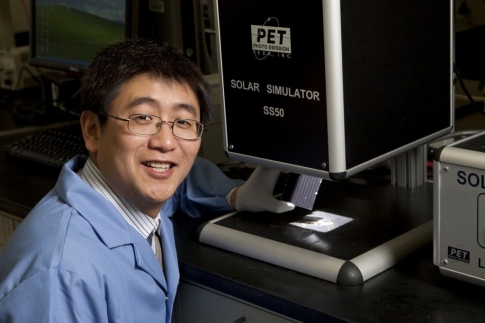Researchers find way to improve perovskites

An international team of scientists has mapped out a way to improve the performance of hybrid perovskite solar cells and make them commercially viable.
"In short, we have found a clean and effective way to push perovskite photovoltaic materials toward their best performance," says Tao Xu (pictured above), a member of the research team who is a chemistry and biochemistry professor from Northern Illinois University.
The team's study was published recently in the Proceedings of the National Academy of Sciences. Xu co-designed the project, and co-wrote the PNAS article with first author Lingping Kong of the Center for High Pressure Science and Technology Advanced Research in Shanghai.
The sun emits a mixture of lights with different colors ranging from blue to red. In general, blue light creates more energetic carriers, but if the cells are designed to capture only blue light, the carrier numbers are less abundant.
One of the major challenges with perovskite solar cells is to improve the material's absorption of red light while retaining the long lifetime of the charge carriers in perovskite materials.
Xu and colleagues overcame the challenge by tuning the perovskite structures via hydrostatic pressure. Using this technique, their samples of organic-inorganic hybrid lead trihalide perovskites absorbed redder light while significantly prolonging the charge-carrier lifetimes.
"We discovered a mechanism for tuning the structural parameters of the material under mild pressures and achieved simultaneous enhancement in light absorption and carrier lifetime prolongation, without any adverse chemical or thermal effects," Xu said, adding that carrier lifetimes increased by 70 percent to 100 percent. "We believe this work will create a roadmap for further improvement of hybrid perovskite materials."
Xu's Ph.D. student at NIU, Jue Gong, also was a member of the research team, along with scientists from the Carnegie Institute of Washington, Argonne National Laboratory, the National Renewable Energy Laboratory and other institutions.
'Simultaneous band-gap narrowing and carrier-lifetime prolongation of organic"“inorganic trihalide perovskites' by Lingping Kong et al; PNAS vol. 113 no. 32, 2016


































